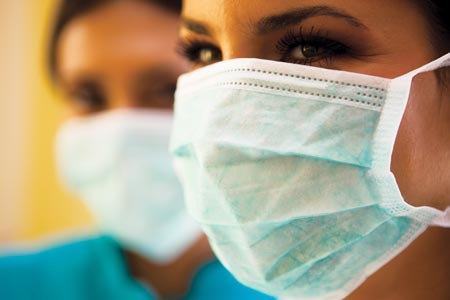Hopkins nurse researcher, assistant professor, and infection control epidemiologist Jason Farley, PhD, MPH, CRNP is working to give nurse colleagues the research-based tools they need to identify, prevent, and destroy drug-resistant infections.
“No one knows about infection control better than nurses,” Farley notes. “It’s where our profession’s evidence-based roots began; nurses will continue to be on the front lines of infection prevention and public education tomorrow.”
In the midst of a global pandemic of novel influenza A (commonly called H1N1 or swine flu)–in which an estimated 3,900 people died between April and October 17 this year–Farley shares his knowledge with Johns Hopkins Nursing to help nurses like you stay safe while providing excellent patient care.
About H1N1

Transmission
H1N1 is transmitted like other influenza viruses, by droplet transmission, such as when an infected person coughs or sneezes near a susceptible person. It can also be transmitted when contaminated hands touch mucous membranes like the nose or eyes.
Symptoms
Fever, chills, headache, upper respiratory tract symptoms, muscle and joint aches, fatigue, vomiting, or diarrhea. Most cases to date have experienced a fever plus cough and/or sore throat.
Infectious period
One day before to 7 days following illness onset. Children may be infectious for up to 10 days.
Medical Care
Patients with severe illness and those at high risk for complications should contact their healthcare provider.
Infection Control
Hand washing or use of alcohol-based gels (such as Purell) is the single best way to prevent infection.
Cover your nose and mouth with a tissue when you cough or sneeze. Throw the tissue in the trash after you use it.
If you get sick, stay home from work or school and limit contact with others to keep from infecting them.
Help Prevent Transmission
1. Post Visual Alerts. Post signs in your workplace instructing patients and visitors to report any symptoms of a respiratory infection. Encourage them to practice respiratory hygiene and cough etiquette.
2. Practice Respiratory Hygiene and Cough Etiquette. Cover the nose and mouth when coughing or sneezing.
Use tissues and dispose of them in the nearest waste receptacle after use.
Wash your hands with soap and water or an antiseptic handwash.
Provide patients with tissues and no-touch waste receptacles.
Provide patients with antiseptic hand-wash or supplies for hand washing.
3. Mask and Separate Patients with Respiratory Symptoms. Offer procedure masks or surgical masks to patients who are coughing, and encourage them to sit at least three feet away from others in common waiting areas.
4. Protect Yourself. Wear a surgical or procedure mask when examining a patient with symptoms of a respiratory infection, particularly if fever is present.
If Patients Have H1N1
Confirmed, probable, or suspected cases
Isolate the Patient
Place patient in individual room with the door kept closed. When transporting patients, use isolation precautions, such as a surgical mask.
Limit healthcare personnel in the room to those performing direct patient care.
Limit visitors to those necessary for the patient’s emotional well-being and care.
Use isolation precautions
Healthcare providers and visitors should don gloves, gowns, eye protection, and a fit-tested disposable N95 respirator (or equivalent) upon room entry.
Wash hands with soap and water or alcohol-based hand sanitizer immediately after removing gloves and after any contact with respiratory secretions.
Use such precautions for seven days from symptom onset or until the resolu-tion of symptoms, whichever is longer.
Monitor healthcare personnel
Check daily for signs and symptoms of febrile respiratory illness.
Healthcare personnel who develop these symptoms should cease patient care activities for seven days–or until symptoms have resolved, whichever is longer–and notify their supervisor and infection control personnel.
Know the contingency plan
Become familiar with your facility contingency response and/or pandemic response plans, including managing increasing patient volume and potential staffing limitations.
Monitor www.cdc.gov/swineflu and state and local health department websites for the latest information.
Sources:
www.cdc.gov/h1n1flu/guidelines_infection_control.htm
http://www.cdc.gov/flu/professionals/infectioncontrol/resphygiene.htm
